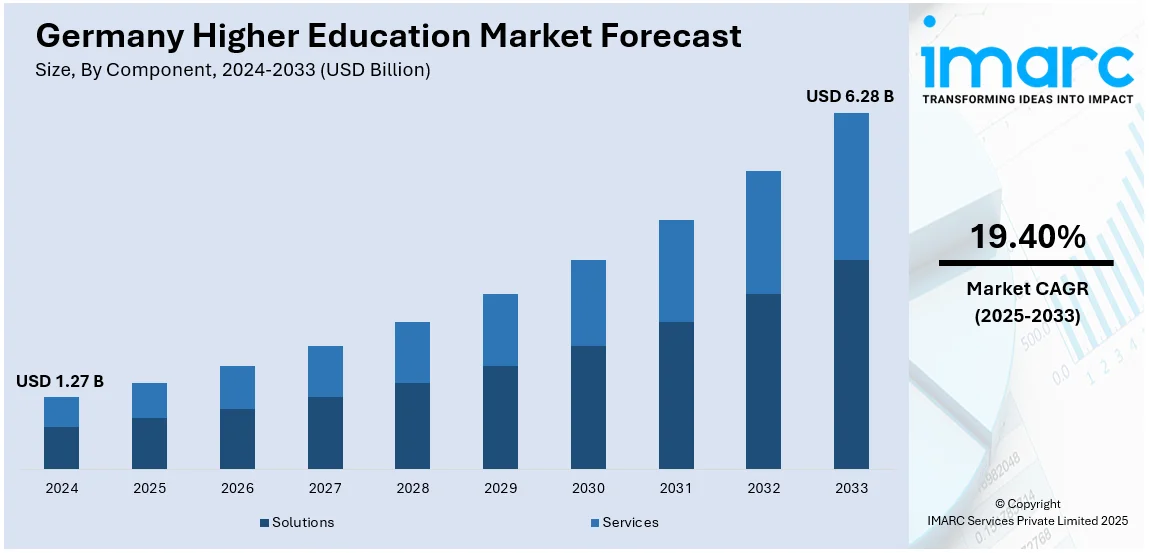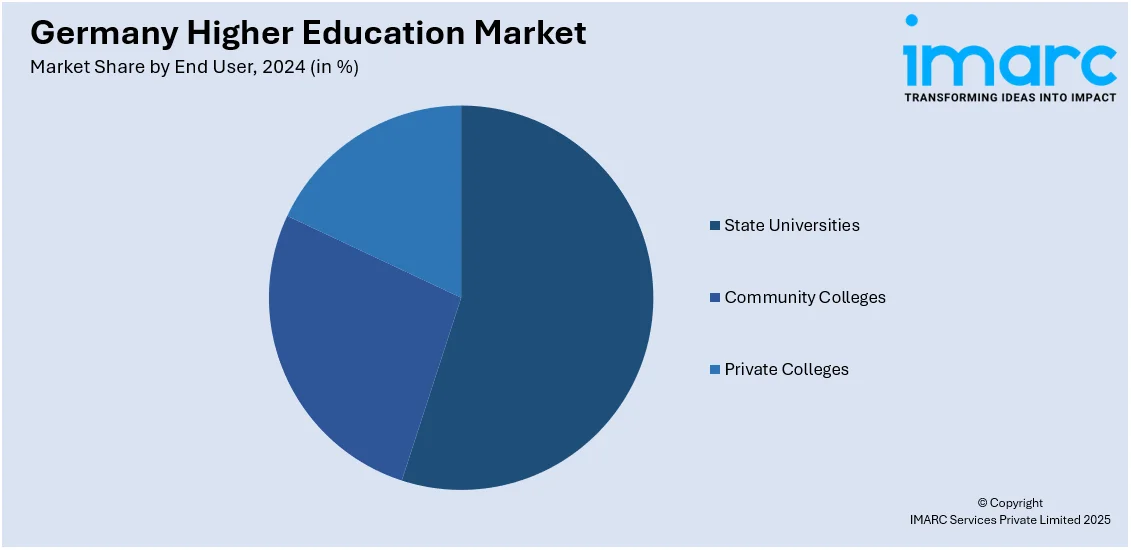
Germany Higher Education Market Size, Share, Trends, and Forecast by Component, Deployment Mode, Course Type, Learning Type, End User, and Region, 2025-2033
Germany Higher Education Market Overview:
The Germany higher education market size reached USD 1.27 Billion in 2024. Looking forward, IMARC Group expects the market to reach USD 6.28 Billion by 2033, exhibiting a growth rate (CAGR) of 19.40% during 2025-2033. The market is expanding due to strong government funding, rising international student enrollment, and digital transformation in learning. Germany accounted for 4.2% of the global higher education market in 2023. In winter semester 2023/24, total enrollment reached 2.9 million students, including 469,485 international students according to CHE Hochschuldaten. India and China were the leading sources of foreign enrollments. Universities are adopting AI-driven platforms and STEM and business programs remain in high demand.
|
Report Attribute
|
Key Statistics
|
|---|---|
|
Base Year
|
2024 |
|
Forecast Years
|
2025-2033
|
|
Historical Years
|
2019-2024
|
| Market Size in 2024 | USD 1.27 Billion |
| Market Forecast in 2033 | USD 6.28 Billion |
| Market Growth Rate (2025-2033) | 19.40% |
Germany Higher Education Market Trends:
Increasing Digitalization in Higher Education
Germany’s higher education sector is undergoing rapid digital transformation, influenced by online collaboration tools, e-learning adoption, and Germany online education platforms market expansion. Universities are implementing hybrid models combining in-person and digital learning, improving access and engagement. Government support, particularly through the “DigitalPakt Hochschule,” is financing digital infrastructure upgrades to support seamless delivery of education. Institutions are also investing in AI-driven learning analytics to personalize instruction, improve student retention, and strengthen performance monitoring. According to the International Trade Administration, around 29% of universities and schools in Germany have integrated AI-driven platforms for customized learning. In alignment with Germany’s AI strategy budget of USD 3.3 Billion for 2025, universities are preparing to expand advanced education technologies. Demand for flexible and remote learning options has also grown, especially among international students and professionals seeking further education in Germany through part-time or distance programs. These initiatives confirm Germany’s position as a leader in modern education, accelerating the long-term growth of the Germany education consulting market and reinforcing its global academic competitiveness.

To get more information on this market, Request Sample
Growth in International Student Enrollment
Germany remains a preferable destination for international students mainly because of its exceptional education system, tuition-free public universities, and strong research opportunities. For instance, industry reports indicate that during the winter session of 2024-2025, more than 405,000 international students are anticipated to get enrolled in universities across Germany, in comparison to 380,000 enrolled students during the same session in 2023-2024. The country is currently witnessing a steady increase in non-EU student enrollments, driven by government policies promoting internationalization, such as the "Strategy for the Internationalization of Education, Science, and Research." Universities are expanding their English-taught programs, particularly in STEM and business disciplines, to attract global talent. Additionally, post-study work opportunities and Germany’s strong labor market appeal to students seeking career prospects after graduation. However, challenges such as visa processing delays and housing shortages remain key concerns. The government's continued investment in scholarships, student support services, and academic partnerships is expected to sustain the growth of international enrollments. As a result, Germany's higher education sector is becoming more globally competitive, reinforcing its reputation as a hub for academic excellence and skilled workforce development.
Demand for STEM and Business Courses
The Germany higher education statistics indicate growing demand for STEM and business programs, reflecting both domestic and global workforce needs. Germany’s reputation for strong engineering, technology, and business management training is attracting more international students. Universities are expanding English-taught programs to cater to global learners considering higher study in Germany, particularly from emerging markets. During the 2024/25 winter session, international student numbers rose to more than 405,000 compared with 380,000 in 2023/24, underlining this rising interest. Government policies, such as the “Strategy for the Internationalization of Education, Science, and Research,” actively support program diversification and internationalization. Universities are integrating practical, industry-aligned elements into STEM and business curricula to improve employability outcomes. Post-study work opportunities and a strong labor market further attract students seeking Germany for higher education. While challenges such as visa delays and housing shortages persist, continued investment in scholarships and partnerships reinforces the sector’s ability to support German higher education system. This positions Germany as a global hub for further education in Germany with competitive academic and professional outcomes.
Germany Higher Education Market Segmentation:
IMARC Group provides an analysis of the key trends in each segment of the market, along with forecasts at the region level for 2025-2033. Our report has categorized the market based on component, deployment mode, course type, learning type, and end user.
Component Insights:
- Solutions
- Student Information Management System
- Content Collaboration
- Data Security and Compliance
- Campus Management
- Others
- Services
- Managed Services
- Professional Services
The report has provided a detailed breakup and analysis of the market based on the component. This includes solutions (student information management system, content collaboration, data security and compliance, campus management, and others) and services (managed services and professional services).
Deployment Mode Insights:
- On-premises
- Cloud-based
A detailed breakup and analysis of the market based on the deployment mode have also been provided in the report. This includes on-premises and cloud-based.
Course Type Insights:
- Arts
- Economics
- Engineering
- Law
- Science
- Others
The report has provided a detailed breakup and analysis of the market based on the course type. This includes arts, economics, engineering, law, science, and others.
Learning Type Insights:
- Online
- Offline
The report has provided a detailed breakup and analysis of the market based on the learning type. This includes online and offline.
End User Insights:

- State Universities
- Community Colleges
- Private Colleges
The report has provided a detailed breakup and analysis of the market based on the end user. This includes state universities, community colleges, and private colleges.
Regional Insights:
- Western Germany
- Southern Germany
- Eastern Germany
- Northern Germany
The report has also provided a comprehensive analysis of all the major regional markets, which include Western Germany, Southern Germany, Eastern Germany, and Northern Germany.
Competitive Landscape:
The market research report has also provided a comprehensive analysis of the competitive landscape. Competitive analysis such as market structure, key player positioning, top winning strategies, competitive dashboard, and company evaluation quadrant has been covered in the report. Also, detailed profiles of all major companies have been provided.
Germany Higher Education Market News:
- In May 2025: ApplyBoard launched operations in Germany, marking its first entry into a primarily non-English-speaking market. Partnering with over 10 German universities, the expansion supported international student mobility, strengthening the Germany Higher Education Market by boosting global access, enrollment, and institutional diversity.
- In April 2025: The German University of Digital Science (UDS), Germany’s first fully digital university, officially began teaching. Offering English-taught MBA, master’s, and micro-degree programs, this milestone advanced the Germany Higher Education Market by expanding global digital access and strengthening innovation in higher education delivery.
- In October 2024, Baden-Württemberg announced plans to enable private universities to offer bachelor’s programs in teaching to address teacher shortages. Graduates can teach at private schools, with efforts underway to expand license recognition nationwide. The program mirrors public university curricula, including coursework and mandatory school practicums.
- In February 2024, Takshashila University, a State Private University, announced signing of an MoU with Institute of International Business Relations, Germany, to advance its academic programmes.
Germany Higher Education Market Report Coverage:
| Report Features | Details |
|---|---|
| Base Year of the Analysis | 2024 |
| Historical Period | 2019-2024 |
| Forecast Period | 2025-2033 |
| Units | Billion USD |
| Scope of the Report | Exploration of Historical Trends and Market Outlook, Industry Catalysts and Challenges, Segment-Wise Historical and Future Market Assessment:
|
| Components Covered |
|
| Deployment Modes Covered | On-premises, Cloud-based |
| Course Types Covered | Arts, Economics, Engineering, Law, Science, Others |
| Learning Types Covered | Online, Offline |
| End Users Covered | State Universities, Community Colleges, Private Colleges |
| Regions Covered | Western Germany, Southern Germany, Eastern Germany, Northern Germany |
| Customization Scope | 10% Free Customization |
| Post-Sale Analyst Support | 10-12 Weeks |
| Delivery Format | PDF and Excel through Email (We can also provide the editable version of the report in PPT/Word format on special request) |
Key Benefits for Stakeholders:
- IMARC’s industry report offers a comprehensive quantitative analysis of various market segments, historical and current market trends, market forecasts, and dynamics of the Germany higher education market from 2019-2033.
- The research report provides the latest information on the market drivers, challenges, and opportunities in the Germany higher education market.
- Porter's five forces analysis assist stakeholders in assessing the impact of new entrants, competitive rivalry, supplier power, buyer power, and the threat of substitution. It helps stakeholders to analyze the level of competition within the Germany higher education industry and its attractiveness.
- Competitive landscape allows stakeholders to understand their competitive environment and provides an insight into the current positions of key players in the market.
Key Questions Answered in This Report
The Germany higher education market was valued at USD 1.27 Billion in 2024.
The market is projected to grow at a CAGR of 19.40% during 2025-2033, reaching USD 6.28 Billion by 2033.
Key drivers include rising international student enrollment, strong government funding, and digital transformation in learning with growth in Germany online education platforms market.
Germany allocates substantial funding to its higher education sector through federal and state budgets, supporting tuition-free public universities, research, and digitalization initiatives. In 2025, the government committed approximately USD 3.3 Billion specifically for its national AI strategy, enhancing infrastructure and modernizing the German higher education system.
Need more help?
- Speak to our experienced analysts for insights on the current market scenarios.
- Include additional segments and countries to customize the report as per your requirement.
- Gain an unparalleled competitive advantage in your domain by understanding how to utilize the report and positively impacting your operations and revenue.
- For further assistance, please connect with our analysts.
 Request Customization
Request Customization
 Speak to an Analyst
Speak to an Analyst
 Request Brochure
Request Brochure
 Inquire Before Buying
Inquire Before Buying




.webp)




.webp)












